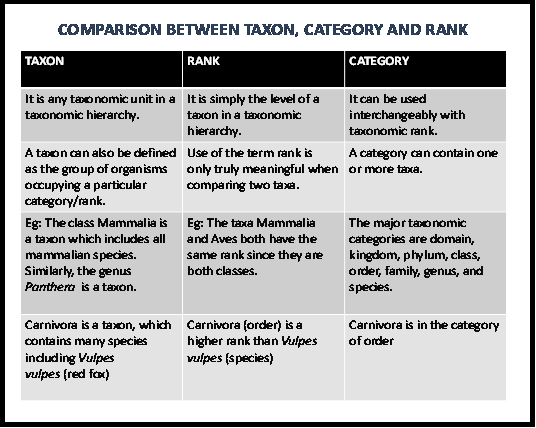Taxonomic categories

`color{blue} ul(mathtt ("Taxon"))` : It is the basic unit of classification which represents a rank containing a group of organisms with
similar distinctive characters.
`color{green} ✍️ color{green} mathbf("KEY CONCEPT")`
● Classification of organisms involves a `color{violet}"hierarchy"` of steps in which each step represents a rank or category.
● Such category is called `color{violet}"taxonomic category"` as it is a part of overall taxonomic arrangement and all categories together constitute the taxonomic hierarchy.
● Each category, referred to as a `color{violet}"unit of classification"` , represents a `color{violet}"rank"` and is commonly termed as `color{violet}"taxon"` (pl.: taxa).

Eg .:The group represented by insects share common features like three pairs of jointed legs can. It means insects are recognisable concrete objects which can be classified, and thus are given a rank or category.
● These taxonomic groups/ categories are `color{violet}"distinct biological entities"` and not merely morphological aggregates.
● The basic requirement to assign a taxon is the knowledge of characters of an individual or group of organisms. This helps in
identifying similarities and dissimilarities among the individuals of the same kind of organisms as well as of other kinds of organisms.
● Taxonomical studies of all known organisms have led to the development of common categories such as kingdom, phylum or division (for plants), class, order, family, genus and species. These are broad categories, also called `color{violet}"obligate or common categories."`
● All the members of a specific taxonomic category possess features different from those of others.
`color{Brown}"Maximum similarity is observed in the lowest category of each classification ie., Species"`
● However, taxonomists have also developed sub-categories in this hierarchy to facilitate more sound and scientific placement of various taxa. These sub categories are called `color{violet}"Intermediate categories."` These include sub- species( varieties), sub- genus, sub-family, sub-order, sub-class and sub- phyla.
`color{brown}"With the rise in Hierarchy, the similarity among characters decreases"`

`color{purple}♣ color{green} "Mneumonic Aid (for taxonomy order)"`:
`color{violet}"K"`ing `color{violet}"P"`hillip `color{violet}"C"`ame `color{violet}"O"`ver `color{violet}"F"`rom `color{violet}"G"`reat `color{violet}"S"`pain
similar distinctive characters.
`color{green} ✍️ color{green} mathbf("KEY CONCEPT")`
● Classification of organisms involves a `color{violet}"hierarchy"` of steps in which each step represents a rank or category.
● Such category is called `color{violet}"taxonomic category"` as it is a part of overall taxonomic arrangement and all categories together constitute the taxonomic hierarchy.
● Each category, referred to as a `color{violet}"unit of classification"` , represents a `color{violet}"rank"` and is commonly termed as `color{violet}"taxon"` (pl.: taxa).

Eg .:The group represented by insects share common features like three pairs of jointed legs can. It means insects are recognisable concrete objects which can be classified, and thus are given a rank or category.
● These taxonomic groups/ categories are `color{violet}"distinct biological entities"` and not merely morphological aggregates.
● The basic requirement to assign a taxon is the knowledge of characters of an individual or group of organisms. This helps in
identifying similarities and dissimilarities among the individuals of the same kind of organisms as well as of other kinds of organisms.
● Taxonomical studies of all known organisms have led to the development of common categories such as kingdom, phylum or division (for plants), class, order, family, genus and species. These are broad categories, also called `color{violet}"obligate or common categories."`
● All the members of a specific taxonomic category possess features different from those of others.
`color{Brown}"Maximum similarity is observed in the lowest category of each classification ie., Species"`
● However, taxonomists have also developed sub-categories in this hierarchy to facilitate more sound and scientific placement of various taxa. These sub categories are called `color{violet}"Intermediate categories."` These include sub- species( varieties), sub- genus, sub-family, sub-order, sub-class and sub- phyla.
`color{brown}"With the rise in Hierarchy, the similarity among characters decreases"`

`color{purple}♣ color{green} "Mneumonic Aid (for taxonomy order)"`:
`color{violet}"K"`ing `color{violet}"P"`hillip `color{violet}"C"`ame `color{violet}"O"`ver `color{violet}"F"`rom `color{violet}"G"`reat `color{violet}"S"`pain











